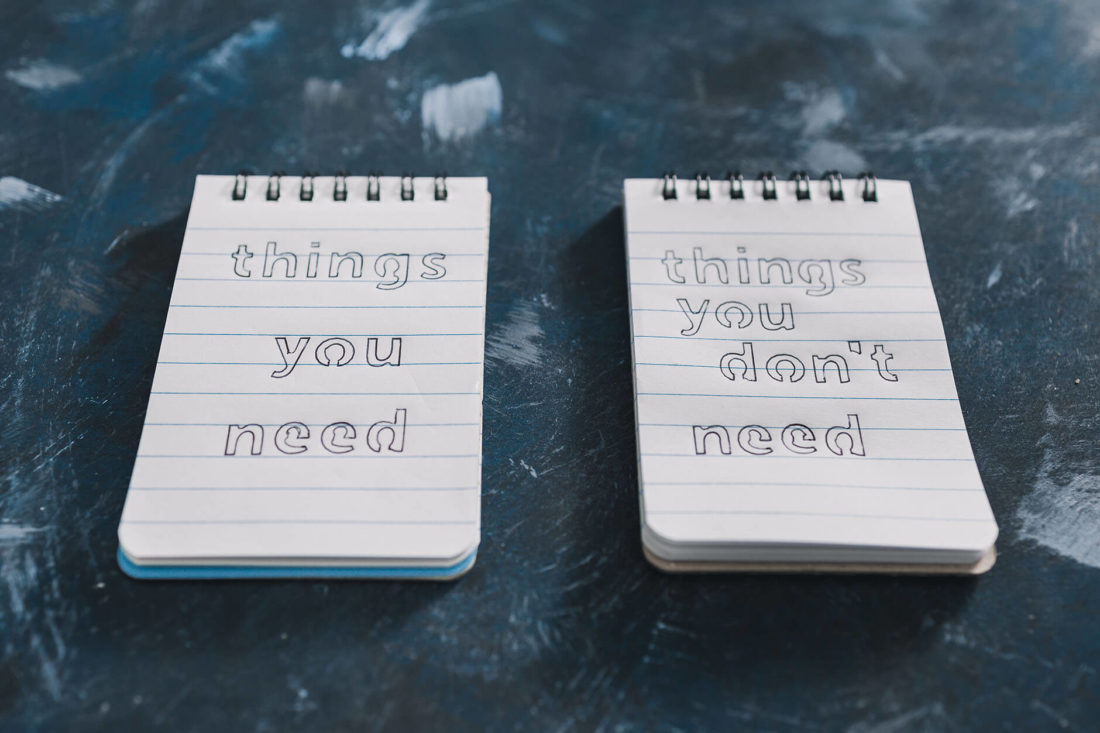How to downsize for a move is one of those questions that don’t come up often, but when they do, you know that you have to be smart because there’s too much at stake – time, energy, money, and a new home you’ve been dreaming of for so long. But there’s no need to worry. No matter how intimidating it appears, we are here to make it as easy as the usual spring clean you do on weekends.


How Do You Downsize Things?
No matter how big or small the house you currently live in is, when relocating to a new state, thinking about downsizing comes naturally, at least if you plan to move somewhat efficiently. We’re all well aware that decluttering your place isn’t hard just because it’s a physically demanding task but because the biggest part of the challenge is our emotional attachment to the things we own. So learning to deal with both emotional clutter and the stuff accumulated over the years is the winning combination in this case. Let’s dive right into learning how to downsize when moving.
Make a Proper Plan Well in Advance
How do I start decluttering to move is a question that’s probably in the back of your mind all the time, but all the strategies won’t help without setting up a good plan early enough. In fact, as soon as you decide to move, start creating one, simply because these things always take much longer than you expect.
You can even create a moving binder, with all information needed in one place, along with your decluttering plan and precise schedule. One thing is sure. It will make the entire process less chaotic.
Go One Room at a Time
Downsizing your whole place is a herculean task, and the best way is to tackle it is in stages. Knowing where you’re starting would undoubtedly be helpful, so you don’t end up in the kitchen, for example, even though you were in the bedroom just a few minutes ago. And then, before you even know it, you’ll find yourself in the basement. At the end of the day, you’ll be drowning in a mountain of clutter with no idea what to do with all that stuff.
Therefore, choose the room you want to purge first, break it down into smaller zones or sections, and jump into it.
Have a Vision of Your New Home
We’re pretty sure you already have a neatly prepared new apartment shopping list waiting in your pocket. Still, you should consider a couple of equally important things when envisioning your future household.
For starters, have the floor plan with you because it will be your only guide when deciding what to keep and what to get rid of. Being able to see the future layout is vital to determine if it is possible to bring all the bulky objects with you, such as tables, closets, sofas, chairs, and other pieces of furniture. Also, this is a perfect moment to eliminate rooms you may not have in your next home and to set the content from these areas aside, so you can think through what you would like to do with it.


Create a Detailed Home Inventory Before You Start Downsizing
If you’re wondering how to downsize a home, one thing is sure: it wouldn’t be possible without a household inventory list. It’s crucial to document all your belongings, the condition of the things you’re bringing, and their value. More importantly, a well-structured inventory list will help you keep track of your possessions and their whereabouts. Creating it is as simple as writing everything down on a piece of paper, without much of a fuss, so that you can stay organized down the road. Taking a photo record as proof of what you own is recommended, too. Once you are sure you have everything covered, you are ready to move on to the next step.
You’ll Save Some Money Along the Way
And yes, we have some good news for you. Purging your space will undoubtedly save you more money than you hoped for. Just think about it. Every reputable long-distance moving company will quote you based on the size of the move. The smaller it is, the less professional packing and other moving services are required, lowering the final price.
So whether you are relocating for the first time on a budget or just trying to set a relocation budget for the upcoming adventure, the decision to purge a space only after you move could cost you some big bucks.
Get Rid of Unnecessary Things Before Moving Houses
Whatever your reasons to move are, whether you are doing it for love or you may be relocating for a job, cutting your belongings down to at least a manageable amount is what you should strive for, especially if you’re relocating alone. Use common sense. How would you handle all those things? Hauling an entire living space with you must be pretty hard to do; otherwise, it wouldn’t be considered one of the biggest relocation mistakes.
Sort Your Belongings Into Categories
This is where you have to be tough. Going through your stuff will only make you feel more sentimental than you already are, which will make categorizing almost pointless. The only two piles you need are the “Keep” and the “Get rid of” pile. However, when emotions start to interfere, we assume you’ll quickly create the third one – the “Keep in storage” pile. Try not to fall for that one because you’ll push yourself to find some more space for things you don’t need. And once you start doing it, there’s no turning back.
Your moving essentials are a whole different story. They should be set aside as a separate category for practical reasons only. Forgetting to do so will only worsen things.
The Best Questions to Ask Yourself Before Leaving Things Behind
Since the fate of your belongings is in your hands, you’d better think before you dispose of some of them since you’ll have no one to blame once they’re gone. That’s why it’s essential to answers these questions before you leave your items behind:
- Is this something I need?
- Would I buy the same one today?
- Is it in good condition, or am I just emotionally attached to it?
- Do I already have something similar?
- Is it worth relocating?
Although these are not the easiest questions to answer, they will allow you to keep your focus on the stuff you love and find meaningful.
Start With the Heavy Items
Starting with large items is always a good idea when downsizing your place. For example, eliminating your old or unused furniture can go a long way: less heavy-lifting and much more space to use. The same goes for unwanted appliances, and tons of books you haven’t opened in years.
All these objects are mere decorations. Maybe they used to have a different purpose, but today they’ve lost their practical use. So if your furniture is there just for the sake of it, maybe someone else would appreciate it more.
Donate, Sell, or Give Away Unwanted Items
When you finally identify what’s coming with you, choosing how to get rid of the rest of your belongings should be based on their condition:
- Donate – Ask around if any charity organization nearby would be glad to have your unwanted items. Although used, be sure that things are not stained or damaged. If you are relocating with kids, donating clothes they’ve outgrown to charities like Red Cross is always the way to go.
- Have a garage sale – If you want to find a way to cut down on your belongings and make some quick cash at the same time, a successful garage sale is an option for you. Save all your best stuff for this one, buy some pricing stickers and name your prices.
- Give them as a gift to family and friends – Set aside some things that are in good shape for the people you love. It will be an excellent way to show them that you care, and they’ll have a fond memory of you once you head off.
To learn how to set up a successful yard sale, check out the video below.
Digitize Important Documentation
Let’s face it. Almost every home is buried under a mountain of paper – newspapers, magazines, periodicals, books, pamphlets, brochures. You name it. Add all of your paperwork to the mix, and your head starts to spin. That’s why it is crucial that you learn one of the best relocation hacks when it comes to organizing important documents.
Going paperless means learning to manage your documentation digitally. Furthermore, it means you can use all these boxes and cabinets to pack something else rather than a pile of dusty papers. However, remember that once you create a digital environment, you have to maintain it and minimize incoming paper.
Be Careful When Disposing of Sensitive Documents
Juggling so many things at once will quickly make the important stuff slip your mind. Disposing of documentation with sensitive information can be one of them, but in that case, you are risking finding yourself in trouble. First, you should know what documents need to be appropriately destroyed:
- Legal and medical documentation,
- Financial records, information, and statements,
- Expired personal documentation, such as ID and passport,
- Expired credit cards or debit cards.
You don’t need a shredder to destroy critical data, although having one at home is undoubtedly the simplest way to ensure you’re keeping your info safe. But regular scissors will do. Just be sure to remove data such as your social security number.


Use Storage Spaces the Best You Can to Pack More Easily
Utilizing your storage spaces is essential when downsizing your living space, especially when your future house is smaller than the current one. Not every house has a basement, an attic, or a garage, so take advantage of other home areas and let them serve as creative storage ideas. There are many small apartment ideas with multifunctional furniture, like storage ottomans and alike. If this doesn’t help, renting self-storage is a great solution.


Now You Know How to Downsize for a Move and Value Simplicity
Dieter Rams once said, “Less, but better,” and we couldn’t agree more. Even though you can’t take a wrong turn with our tips, even being guided by this phrase only will ensure you’re on the safe side when minimizing.





